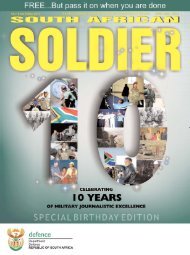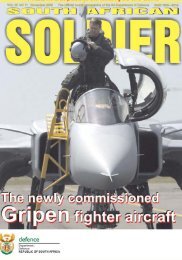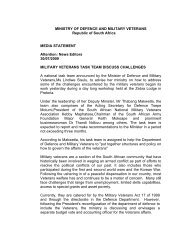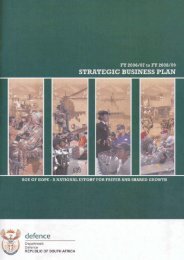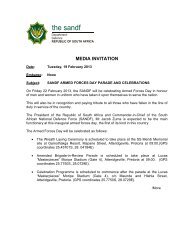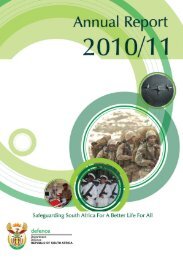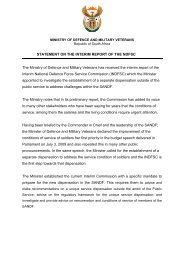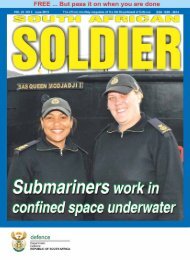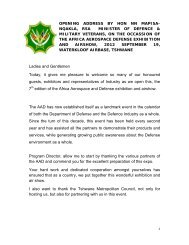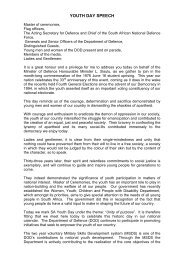Chapter 2 - P rogramme 1 - Department of Defence
Chapter 2 - P rogramme 1 - Department of Defence
Chapter 2 - P rogramme 1 - Department of Defence
You also want an ePaper? Increase the reach of your titles
YUMPU automatically turns print PDFs into web optimized ePapers that Google loves.
| Appendix A - Status <strong>of</strong> the SANDF Reserves |<br />
widened to include engineers and chaplains. To date,<br />
14 Reserve infantry companies have been deployed<br />
on internal and external operations. In addition,<br />
during Operation BATA, during the public service<br />
strike, 20% <strong>of</strong> the total infantry and medical orderly<br />
deployments comprised Reserve members.<br />
The use <strong>of</strong> Reserve Squadron aircraft has resulted in<br />
increased flying hours from the 148 civilian aircraft<br />
currently available to the SA Air Force. The SA Navy<br />
has 15% <strong>of</strong> its Reserves under call-up at any one<br />
time, with berths being available on the new frigates<br />
and submarines.<br />
The percentage <strong>of</strong> the call-up for duty per Service,<br />
as measured against the actual strength <strong>of</strong> the<br />
Reserves in FY 2007/8, was:<br />
SA Army 64%<br />
SA Air Force 57%<br />
SA Navy 24%<br />
SAMHS 28%<br />
Further details on the status <strong>of</strong> the Reserves are<br />
found under the <strong>Defence</strong> Reserves Division report,<br />
within the Administration P<strong>rogramme</strong>.<br />
Leader Group Development<br />
The transformation <strong>of</strong> the Reserves is largely<br />
dependent on the creation <strong>of</strong> a new cadre <strong>of</strong> leaders.<br />
The SA Army is currently training an average <strong>of</strong> 200<br />
young Reserve <strong>of</strong>ficers and NCOs per annum. The<br />
training <strong>of</strong> Reserve leaders is <strong>of</strong> the same standard<br />
and duration as that for their Regular counterparts.<br />
The SA Air Force, Navy and Military Health Services<br />
have similar p<strong>rogramme</strong>s in place. In addition,<br />
SAMHS continues with the development <strong>of</strong> the<br />
University Reserve Training Unit.<br />
Ceremonial<br />
The enhanced capacity <strong>of</strong> the Reserves is reflected<br />
in their increasing participation in both local<br />
and international parades and tattoos, with the<br />
maintenance <strong>of</strong> high standards. Highlights include<br />
the opening <strong>of</strong> Parliament, the Moscow Tattoo<br />
(Transvaal Scottish), the firing <strong>of</strong> a salute at the<br />
Tower <strong>of</strong> London (Transvaal Horse Artillery) and<br />
exercising the freedom <strong>of</strong> entry into cities and<br />
towns. The revitalisation <strong>of</strong> military tattoo in Cape<br />
Town will be expanded to Durban in 2008 and<br />
Gauteng in 2009.<br />
Infrastructure<br />
Annual Report FY 2007 - 2008 202<br />
| <strong>Department</strong> <strong>of</strong> <strong>Defence</strong> |<br />
Progress has been made in improving Reserve<br />
infrastructure such as at Fort iKapa in Cape Town.<br />
A budget is available for the renovation <strong>of</strong> Lords<br />
Ground in Durban and Kensington Garrison in<br />
Johannesburg.<br />
Marketing and Reserves<br />
The marketing and promotion <strong>of</strong> Reserve service<br />
is a key role <strong>of</strong> the <strong>Defence</strong> Reserves Office, via<br />
an activity entitled “Shield”. Shield funds have been<br />
constructively deployed in:<br />
•<br />
•<br />
•<br />
•<br />
•<br />
•<br />
briefing sessions for captains <strong>of</strong> industry;<br />
support <strong>of</strong> military tattoos, shows and parades;<br />
a nationwide advertising campaign in carefully<br />
selected and targeted magazines;<br />
the development <strong>of</strong> the SANDF Reserve<br />
website – www.rfdiv.mil.za; and<br />
the publication twice annually <strong>of</strong> The Reserve<br />
Force Volunteer.<br />
There is every indication that Reserve service is<br />
achieving increased support amongst national<br />
decision-makers, employers, labour and the youth.<br />
Challenges for the Future<br />
The challenges for the future, which are being<br />
addressed, include:<br />
•<br />
•<br />
•<br />
•<br />
•<br />
continuation training for Reserve units, with<br />
a concomitant improvement in readiness.<br />
This budget constraint is currently the most<br />
significant weakness in the Reserve System;<br />
ongoing transfer <strong>of</strong> MSDS members to the<br />
Reserves and the possible implementation <strong>of</strong><br />
new feeder systems;<br />
the motivation <strong>of</strong> MSDS members to serve in<br />
the Reserves;<br />
incentivisation <strong>of</strong> Reserves; and<br />
widening the employer support base.



